A Newly Hybrid Method Based on Cuckoo Search and Sunflower Optimization for Optimal Power Flow Problem
Abstract
1. Introduction
- Dealing with OPF frameworks with several objective functions conditions using a hybrid HCSA-SFO algorithm;
- The HCSA-SFO utilizes the mutation and selection mechanism to follow the best orientation to the sun of sunflowers from the SFO algorithm to replace the Lévy flights function in CSA. This technique helps HCSA-SFO to avoid the fixed step size in the CSA, hence the run time is reduced and the quality of solution for the HCSA-SFO algorithm in the OPF problem is improved;
- The simulation result is validated on the standard 30-buses and 118-buses systems;
- The result is compared to many previous methods, which shows the effectiveness of the suggested HCSA-SFO method in dealing with the OPF problem.
2. Problem Formulation
2.1. OPF Objective Functions
2.2. Constraints
3. Implementation of HCSA-SFO for Dealing with the Problem
3.1. SFO Method
- Generate the population randomly, i = 1, ..., n.
- The fitness function of sunflowers is evaluated.
- Retain the best solutions in the sunflower population X*.
- Modify all sunflowers headed for the best one (called sun) as Equation (18).
- Determine the direction for each sunflower by Equation (19).In which,
- λ: Inertial displacement of the sunflower plants.
- pi: Pollination probability.
- Xi, Xi-1: Current position and nearest neighbor position
- Examine the highest step of individual as Equation (20).where,
- Xmin, Xmax: The lower and upper limits.
- Npop: the number of populations.
3.2. CSA Method
- -
- A cuckoo lays its one egg into a bird nest which is selected at random from other host birds.
- -
- The best nests will bear to the next generation.
- -
- A host bird may detect a strange egg by a probability pa є [0, 1]. For this situation, the host bird can throw out the cuckoo’s egg or leave the nest and find another place for building a new one (with new random solutions).
- Xi, Xj and Xk: Current positions selected randomly
- α > 0: Scaling coefficient
- : Position i + 1
- s: Step size
- : Entry-wise product
- H: Heaviside function
- ε: Random number
- L(s, λ): Lévy distribution.
3.3. Implementation of the Hybrid CSA and SFO Method
4. Simulation Results
4.1. The IEEE 30-Bus Test System
4.2. The IEEE 118-Bus Test System
5. Conclusions
Author Contributions
Funding
Conflicts of Interest
References
- Monoh, J.A.; El-Hawary, M.E.; Adapa, R. A review of selected optimal power flow literature to 1993 Part II: Newton, linear programming and Interior Point Methods. IEEE Trans. Power Syst. 1999, 14, 105–111. [Google Scholar] [CrossRef]
- Alsac, O.; Scott, B. Optimal load flow with steady state security. IEEE Trans. Power Appar. Syst. 1974, 93, 745–751. [Google Scholar] [CrossRef]
- Alsac, O.; Bright, J.; Prais, M.; Stott, B. Further developments in LP-based optimal power flow. IEEE Trans. Power Syst. 1990, 5, 697–711. [Google Scholar] [CrossRef]
- Burchett, R.C.; Happ, H.H.; Vierath, D.R. Quadratically convergent optimal power flow. IEEE Trans. Power Appar. Syst. 1984, 103, 3267–3276. [Google Scholar] [CrossRef]
- Sun, D.I.; Ashley, B.; Brewer, B.; Hughes, A.; Tinney, W.F. Optimal power flow by Newton approach. IEEE Trans. Power Appar. Syst. 1984, 103, 2864–2880. [Google Scholar] [CrossRef]
- Ongsakul, W.; Tantimaporn, T. Optimal power flow by improved evolutionary programming. Electr. Power Compon. Syst. 2006, 34, 79–95. [Google Scholar] [CrossRef]
- El-Fergany, A.A.; Hasanien, H.M. Single and multi-objective optimal power flow using grey wolf optimizer and differential evolution algorithms. Electr. Power Compon. Syst. 2015, 43, 1548–1559. [Google Scholar] [CrossRef]
- Hazra, J.; Sinha, A.K. A multi-objective optimal power flow using particle swarm optimization. Eur. Trans. Electr. Power 2011, 21, 1028–1045. [Google Scholar] [CrossRef]
- Duman, S.; Güvenç, U.; Sönmez, Y.; Yörükeren, N. Optimal power flow using gravitational search algorithm. Energy Convers. Manag. 2012, 59, 86–95. [Google Scholar] [CrossRef]
- Bhattacharya, A.; Roy, P.K. Solution of multi-objective optimal power flow using gravitational search algorithm. IET Gener. Transm. Distrib. 2012, 6, 751–763. [Google Scholar] [CrossRef]
- Jahan, M.S.; Amjady, N. Solution of large-scale security constrained optimal power flow by a new bi-level optimisation approach based on enhanced gravitational search algorithm. IET Gener. Transm. Distrib. 2013, 7, 1481–1491. [Google Scholar] [CrossRef]
- El-Sehiemy, R.A.; Shaheen, A.M.; Farrag, S.M. Solving multi-objective optimal power flow problem via forced initialised differential evolution algorithm. IET Gener. Transm. Distrib. 2016, 10, 1634–1647. [Google Scholar]
- Varadarajan, M.; Swarup, K.S. Solving multi-objective optimal power flow using differential evolution. IET Gener. Transm. Distrib. 2008, 2, 720–730. [Google Scholar] [CrossRef]
- Pulluri, H.; Naresh, R.; Sharma, V. A solution network based on stud krill herd algorithm for optimal power flow problems. Soft Comput. 2016, 5, 1–18. [Google Scholar] [CrossRef]
- Adaryani, M.R.; Karami, A. Artificial bee colony algorithm for solving multi-objective optimal power flow problem. Int. J. Electr. Power Energy Syst. 2013, 53, 219–230. [Google Scholar] [CrossRef]
- Ghanizadeh, A.J.; Mokhtar, G.; Abedi, M.; Gharehpetian, G.B. Optimal power flow based on imperialist competitive algorithm. Int. Rev. Electr. Eng. 2011, 6, 1847–1852. [Google Scholar]
- Bhattacharya, A.; Chattopadhyay, P.K. Application of biogeography-based optimisation to solve different optimal power flow problems. IET Gener. Transm. Distrib. 2011, 5, 70–80. [Google Scholar] [CrossRef]
- Warid, W.; Hizam, H.; Mariun, N.; Abdul-Wahab, N.I. Optimal power flow using the Jaya algorithm. Energies 2016, 9, 678. [Google Scholar] [CrossRef]
- Radosavljević, J.; Klimenta, D.; Jevtić, M.; Arsić, N. Optimal power flow using a hybrid optimization algorithm of particle swarm optimization and gravitational search algorithm. Electr. Power Compon. Syst. 2015, 43, 1958–1970. [Google Scholar] [CrossRef]
- Bouchekara, H.R.; Chaib, A.E.; Abido, M.A.; El-Sehiemy, R.A. Optimal power flow using an improved colliding bodies optimization algorithm. Appl. Soft Comput. 2016, 42, 119–131. [Google Scholar] [CrossRef]
- Arul, R.; Ravi, G.; Velusami, S. Solving optimal power flow problems using chaotic selfadaptive differential harmony search algorithm. Electr. Power Compon. Syst. 2013, 41, 782–805. [Google Scholar] [CrossRef]
- Bouchekara, H.R.E.H.; Abido, M.A.; Boucherma, M. Optimal power flow using teaching learning- based optimization technique. Electr. Power Syst. Res. 2014, 114, 49–59. [Google Scholar] [CrossRef]
- Bouchekara, H.R. Optimal power flow using black-hole-based optimization approach. Appl. Soft Comput. 2014, 24, 879–888. [Google Scholar] [CrossRef]
- Lai, L.L.; Ma, J.T.; Yokoyama, R.; Zhao, M. Improved genetic algorithms for optimal power flow under both normal and contingent operation states. Int. J. Electr. Power Energy Syst. 1997, 19, 287–292. [Google Scholar] [CrossRef]
- Attia, A.-F.; Sehiemy, R.A.E.; Hasanien, H.M. Optimal power flow solution in power systems using a novel Sine-Cosine. Int. J. Electr. Power Energy Syst. 2018, 99, 331–343. [Google Scholar] [CrossRef]
- Surender, R.S.; Srinivasa, R.C. Optimal power flow using glowworm swarm optimization. Int. J. Electr. Power Energy Syst. 2016, 80, 128–139. [Google Scholar] [CrossRef]
- Kumari, M.S.; Maheswarapu, S. Enhanced genetic algorithm based computation technique for multi-objective optimal power flow solution. Int. J. Electr. Power Energy Syst. 2010, 32, 736–742. [Google Scholar] [CrossRef]
- Surender, R.S. Solution of multi-objective optimal power flow using efficient meta-heuristic algorithm. Electr. Eng. 2017, 100, 401–413. [Google Scholar]
- Surender, R.S.; Abhyankar, A.R.; Bijwe, P.R. Reactive power price clearing using multi-objective optimization. Energy 2011, 36, 3579–3589. [Google Scholar]
- Surender, R.S. Security constrained optimal power flow with FACTS controllers using hybrid differential evolution and harmony search algorithm. Int. J. Appl. Eng. Res. 2016, 11, 10939–10944. [Google Scholar]
- Surender, R.S.; Bijwe, P.R. Differential evolution-based efficient multi-objective optimal power flow. Neural Comput. Appl. 2017, 31, 509–522. [Google Scholar] [CrossRef]
- Abhishek, R.; Malakar, T. Optimal reactive power dispatch using hybrid Nelder- Mead simplex based firefly algorithm. Int. J. Electr. Power Energy Syst. 2015, 66, 9–24. [Google Scholar]
- Chaib, A.E.; Bouchekara, H.R.; Mehasni, R.; Abido, M.A. Optimal power flow with emission and non-smooth cost functions using backtracking search optimization algorithm. Int. J. Electr. Power Energy Syst. 2016, 81, 64–77. [Google Scholar] [CrossRef]
- Niknam, T.; Narimani, M.; Jabbari, M.; Malekpour, A.R. A modified shuffle frog leaping algorithm for multi-objective optimal power flow. Energy 2011, 36, 6420–6432. [Google Scholar] [CrossRef]
- Sayah, S.; Zehar, K. Modified differential evolution algorithm for optimal power flow with non-smooth cost functions. Energy Convers. Manag. 2008, 49, 3036–3042. [Google Scholar] [CrossRef]
- Yang, X.S.; Deb, S. Cuckoo search via Lévy flights. In Proceedings of the 2009 World Congress on Nature & Biologically Inspired Computing, Coimbatore, India, 9–11 December 2009; pp. 210–214. [Google Scholar]
- Yang, X.S.; Deb, S. Engineering optimisation by cuckoo search. Int. J. Math. Model. Num. Optim. 2010, 1, 330–343. [Google Scholar] [CrossRef]
- Gomes, G.F.; Cunha, S.S.A.; Ancelotti, A.C. A sunflower optimization (SFO) algorithm applied to damage identification on laminated composite plates. Eng. Comput. 2018, 35, 619–626. [Google Scholar] [CrossRef]
- MATPOWER A MATLAB Power System Simulation Package Version 4.1. Available online: http://www.pserc.cornell.edu//matpower/ (accessed on 1 June 2020).
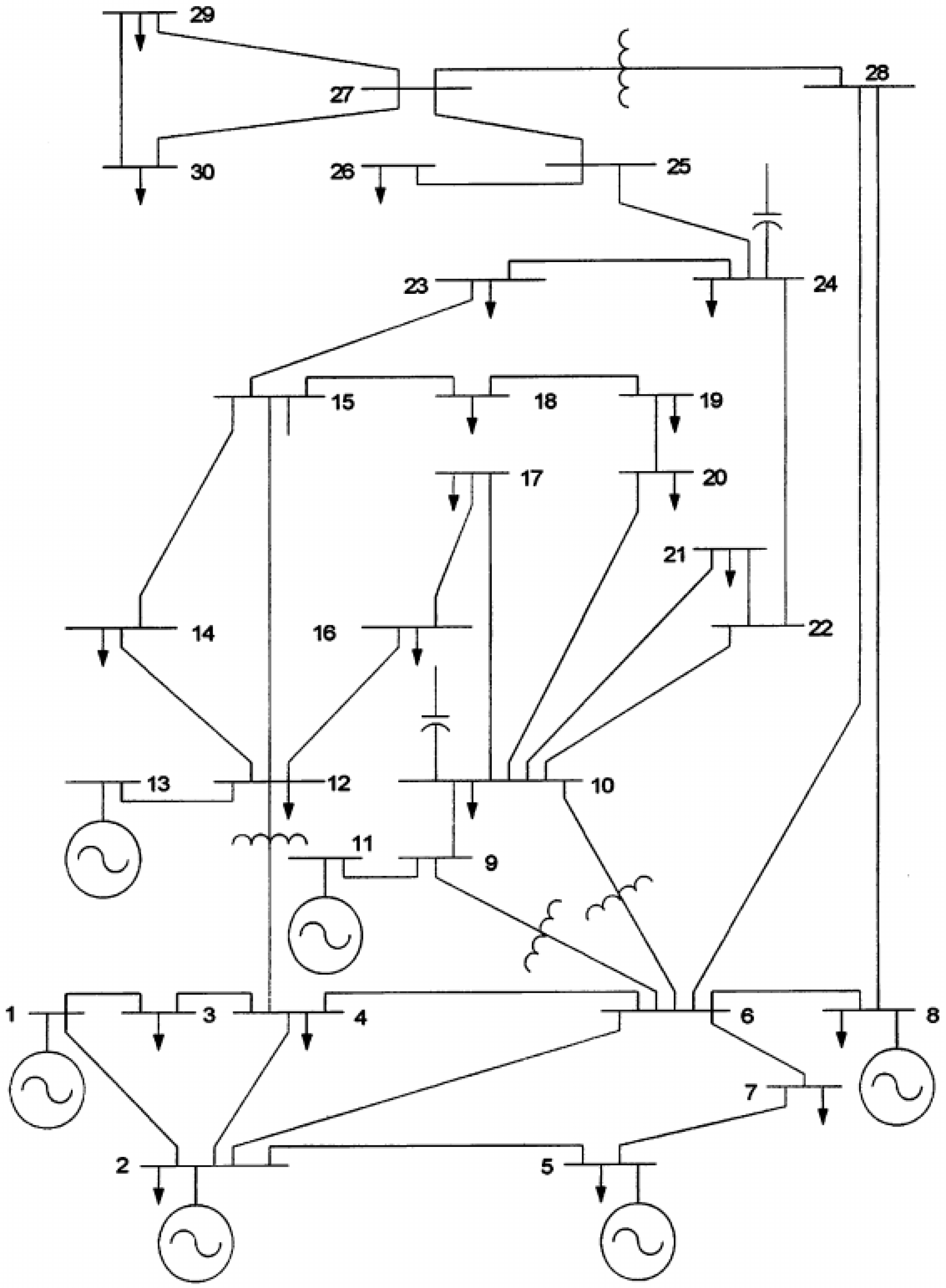
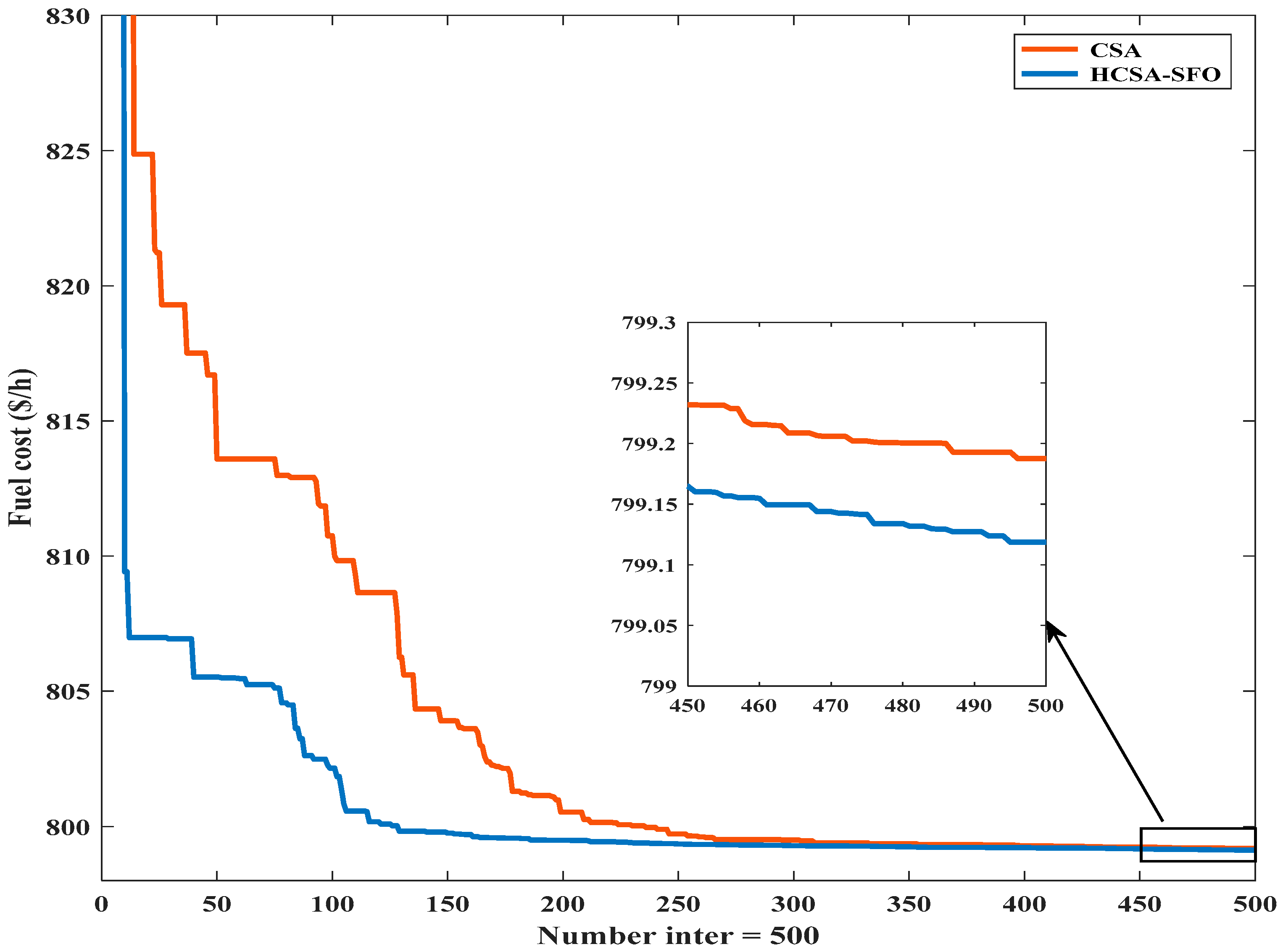
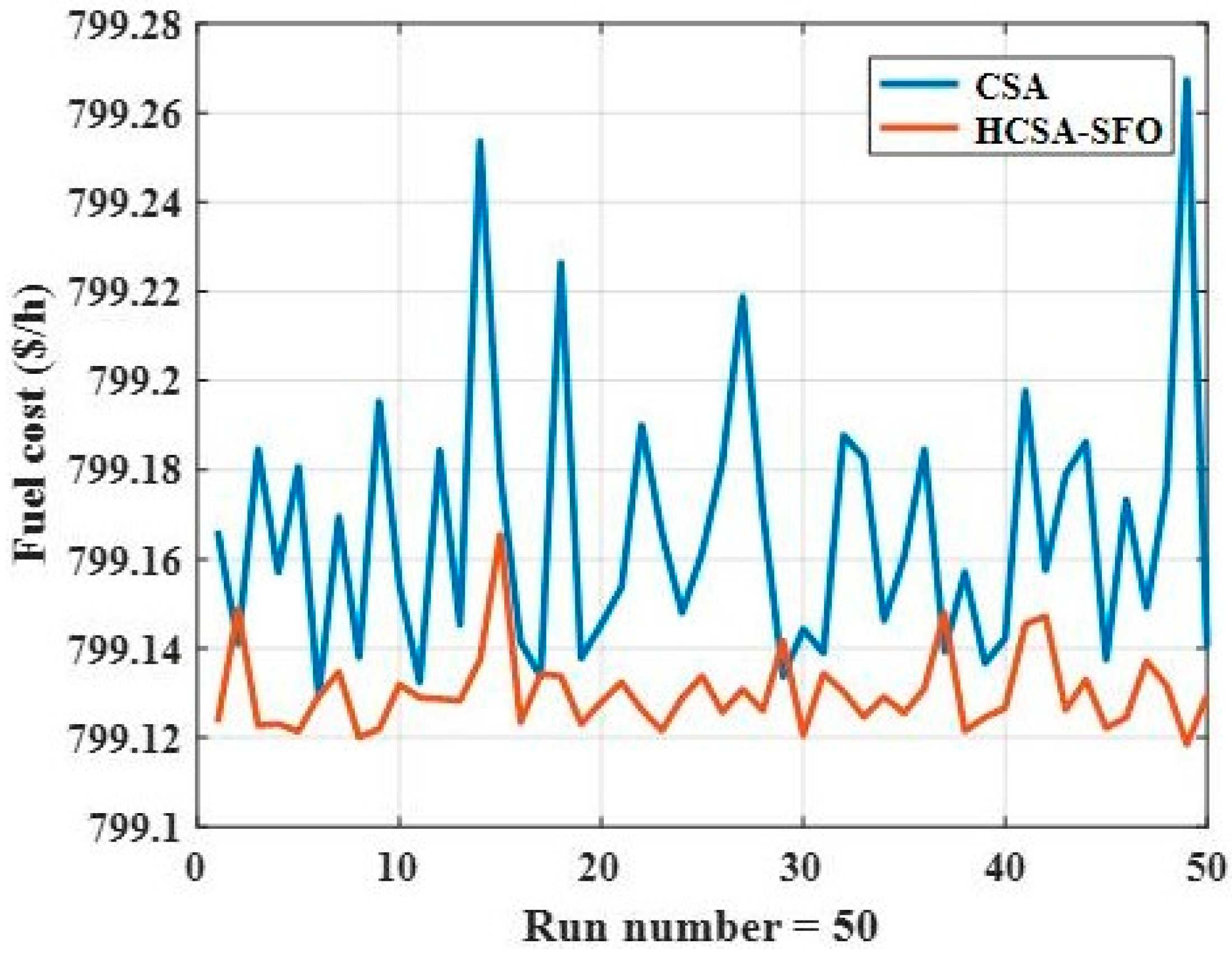
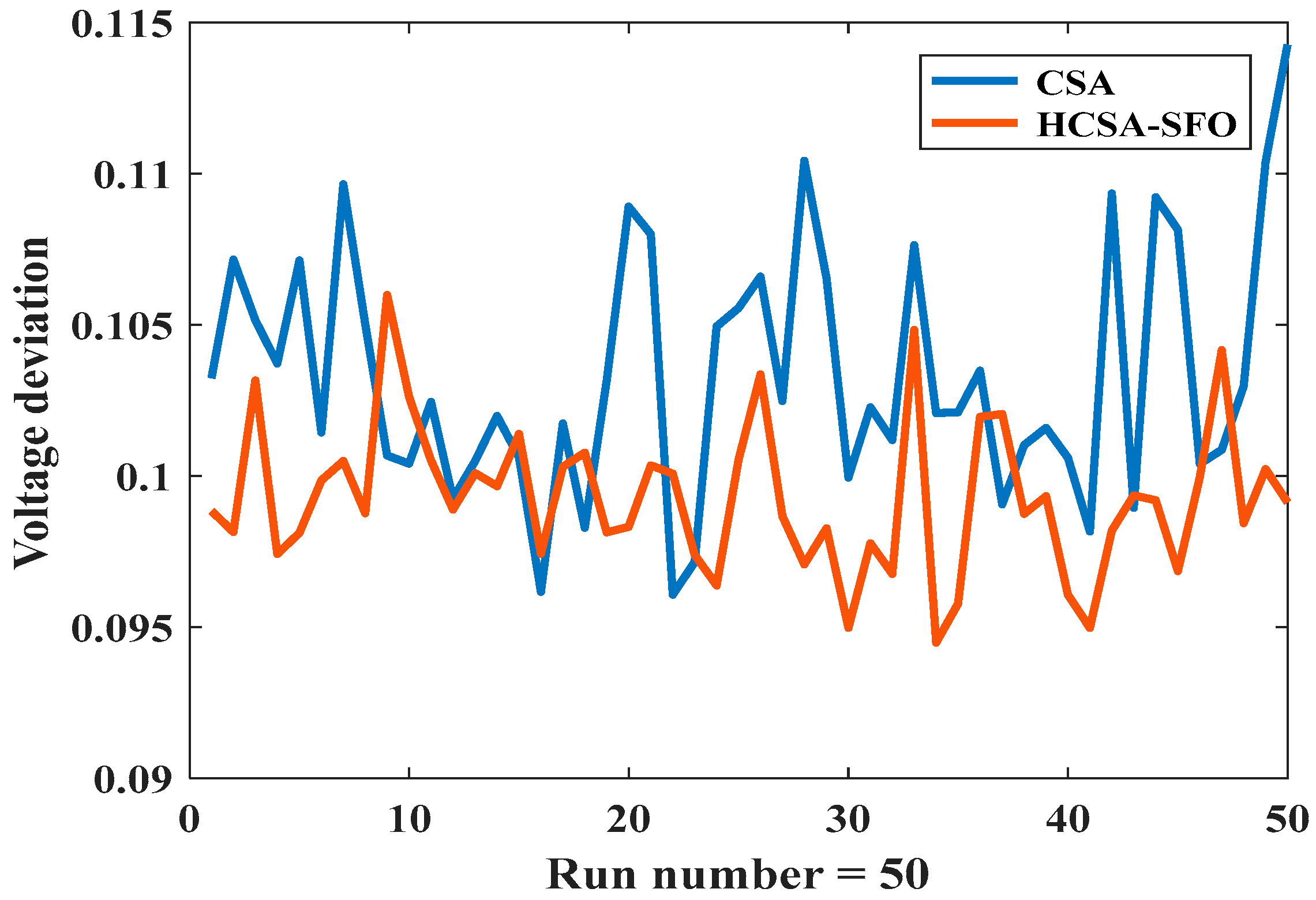
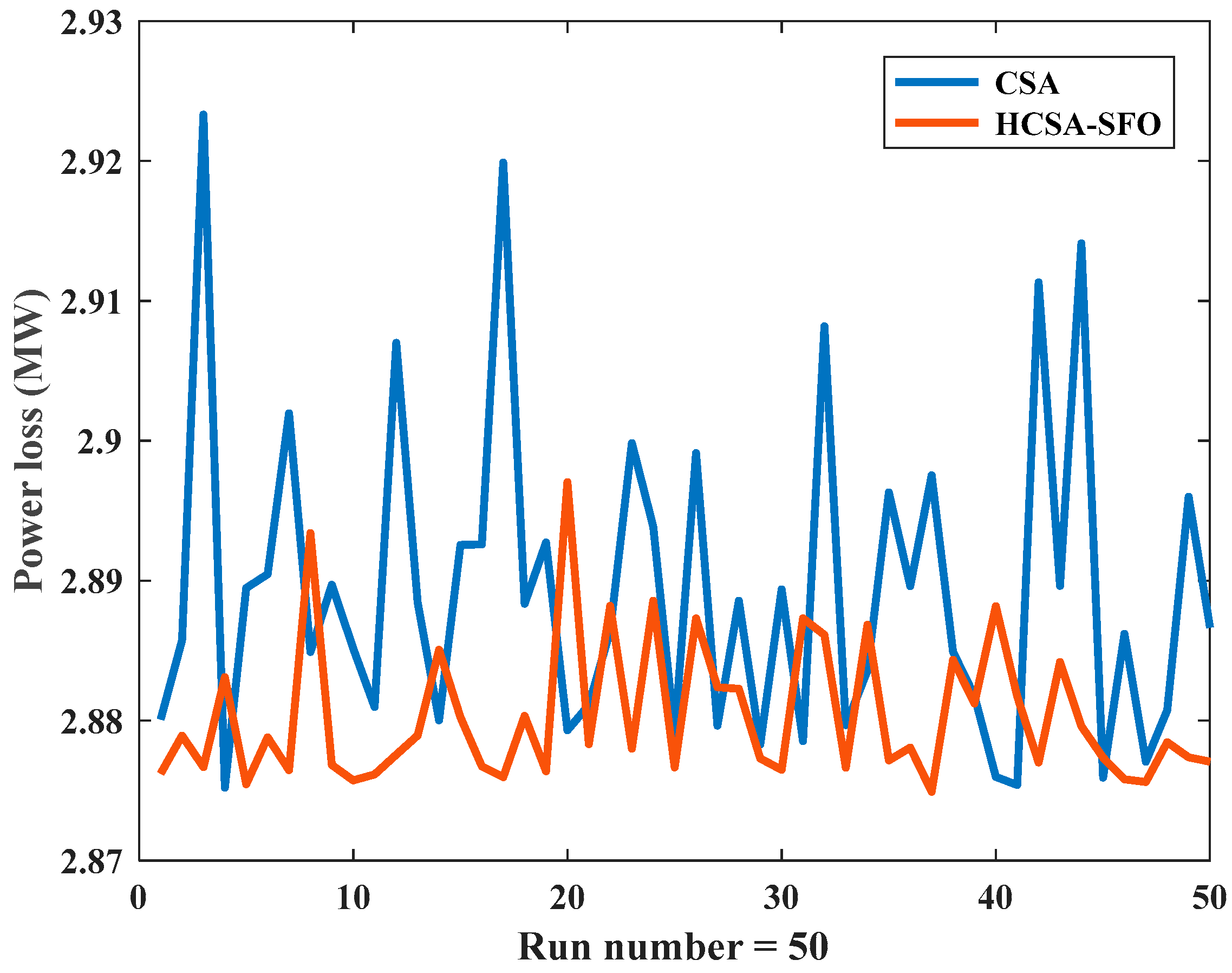
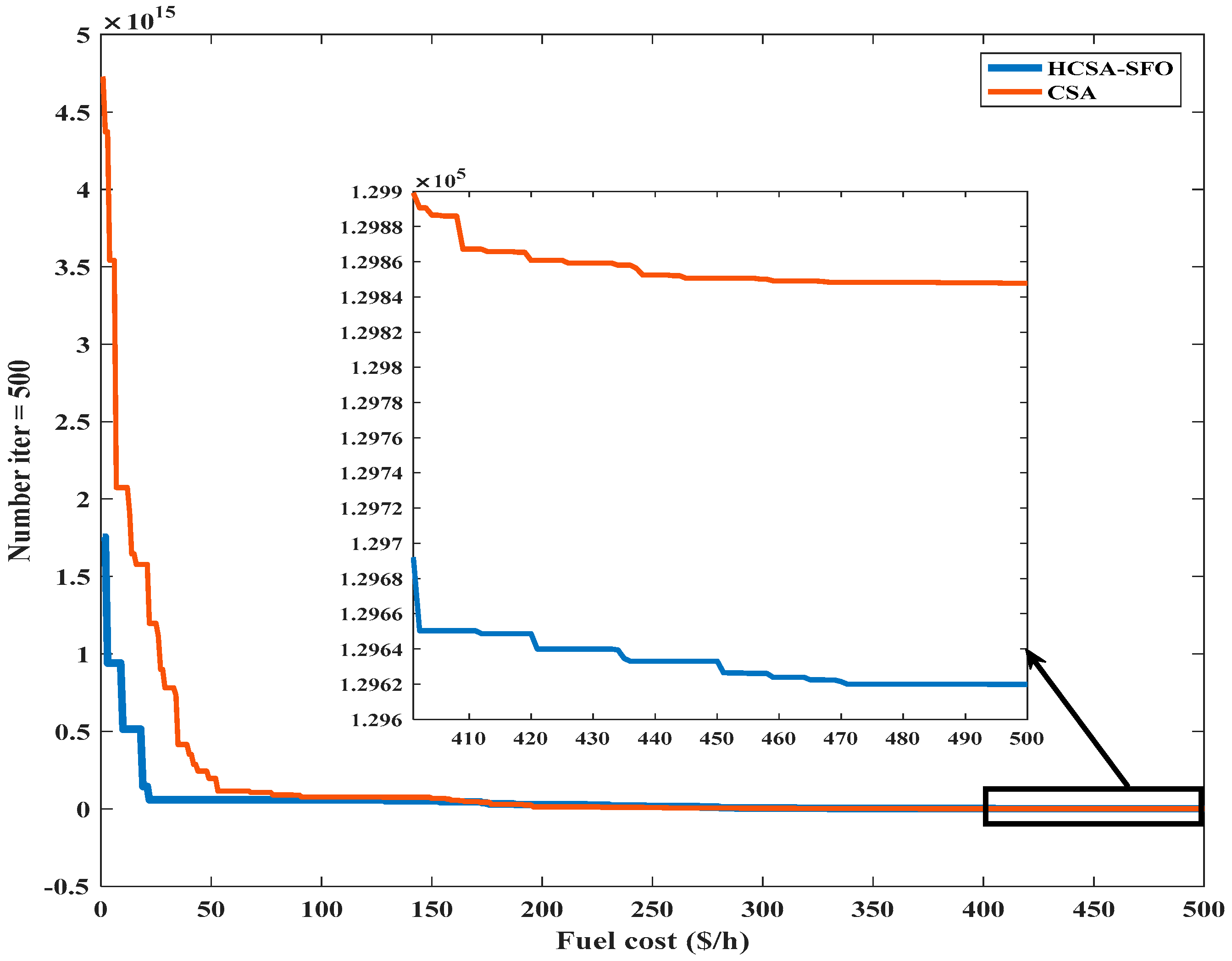
| Generate randomly the n nests |
| For Iter = 1: Itmax do |
| Get cuckoo (call c1) through Lévy flights technique |
| Validate its fitness Fc1 |
| Select randomly a nest (call c2) among n nests |
| If (Fc1 is high performance than Fc2) then |
| Solution c1 substitute for c2 |
| Fitness c1 substitute for c2 |
| End if |
| Desert Pa of worse nests and build new nests |
| Retain the best nests |
| Find the best so far nest Gbest |
| End for |
| Post processing results. |
| Bus No | ai ($/h) | bi ($/MWh) | ci ($/MW2h) |
|---|---|---|---|
| 1 | 0.00 | 2 | 0.00375 |
| 2 | 0.00 | 1.75 | 0.01750 |
| 5 | 0.00 | 1.00 | 0.06250 |
| 8 | 0.00 | 3.25 | 0.00834 |
| 11 | 0.00 | 3.00 | 0.02500 |
| 13 | 0.00 | 3.00 | 0.02500 |
| Control Parameters (U) | Initial State | Limits | Case 1: Total Generator Cost | Case 2: Voltage Profile | Case 3: Total Active Power Loss | ||||
|---|---|---|---|---|---|---|---|---|---|
| Min | Max | CSA | HCSA-SFO | CSA | HCSA-SFO | CSA | HCSA-SFO | ||
| P1(MW) | 99.221 | 50 | 200 | 177.219 | 177.148 | 129.717 | 117.597 | 51.2794 | 51.2795 |
| P2(MW) | 80.0 | 20 | 80 | 48.6847 | 48.7207 | 60.2810 | 48.1157 | 79.9966 | 79.9964 |
| P5(MW) | 50.00 | 15 | 50 | 21.2218 | 21.3127 | 39.4447 | 50.0000 | 50.0000 | 50.0000 |
| P8(MW) | 20.0 | 10 | 35 | 21.1297 | 20.9526 | 18.4269 | 33.2425 | 34.9992 | 34.9995 |
| P11(MW) | 20.0 | 10 | 30 | 11.7964 | 11.9111 | 19.3629 | 23.0321 | 30.0000 | 30.0000 |
| P13(MW) | 20.0 | 12 | 40 | 12.0019 | 12.0000 | 23.3748 | 17.2583 | 40.0000 | 39.9995 |
| V1 (p.u) | 1.0500 | 0.95 | 1.1 | 1.1000 | 1.1000 | 1.0144 | 1.0075 | 1.1000 | 1.1000 |
| V2 (p.u) | 1.0400 | 0.95 | 1.1 | 1.0879 | 1.0878 | 1.0073 | 1.0000 | 1.0977 | 1.0979 |
| V5 (p.u) | 1.0100 | 0.95 | 1.1 | 1.0617 | 1.0615 | 1.0189 | 1.0156 | 1.0798 | 1.0804 |
| V8 (p.u) | 1.0100 | 0.95 | 1.1 | 1.0704 | 1.0693 | 1.0092 | 1.0142 | 1.0875 | 1.0878 |
| V11(p.u) | 1.0500 | 0.95 | 1.1 | 1.0998 | 1.1000 | 1.0179 | 1.0377 | 1.1000 | 1.1000 |
| V13(p.u) | 1.0500 | 0.95 | 1.1 | 1.0999 | 1.1000 | 1.0132 | 1.0176 | 1.1000 | 1.0998 |
| T11 | 1.0780 | 0.9 | 1.1 | 1.0485 | 1.0596 | 1.0315 | 1.0531 | 1.0681 | 1.0650 |
| T12 | 1.0690 | 0.9 | 1.1 | 0.9220 | 0.9000 | 0.9009 | 0.9013 | 0.9001 | 0.9000 |
| T15 | 1.0320 | 0.9 | 1.1 | 1.0023 | 0.9929 | 0.9962 | 0.9911 | 0.9854 | 0.9844 |
| T36 | 1.0680 | 0.9 | 1.1 | 0.9723 | 0.9687 | 0.9579 | 0.9733 | 0.9754 | 0.9748 |
| QC10 (MVAR) | 0 | 0 | 5 | 5.0000 | 5.0000 | 5.0000 | 2.8273 | 4.9999 | 4.9688 |
| QC12 (MVAR) | 0 | 0 | 5 | 4.9779 | 5.0000 | 4.5504 | 1.3736 | 4.9967 | 4.9994 |
| QC15 (MVAR) | 0 | 0 | 5 | 4.8721 | 5.0000 | 5.0000 | 4.9758 | 4.9991 | 4.9935 |
| QC17 (MVAR) | 0 | 0 | 5 | 4.9764 | 5.0000 | 1.1845 | 1.1102 | 4.9897 | 4.9998 |
| QC20 (MVAR) | 0 | 0 | 5 | 4.2118 | 4.4761 | 5.0000 | 4.9997 | 3.8542 | 4.2219 |
| QC21 (MVAR) | 0 | 0 | 5 | 5.0000 | 5.0000 | 4.4159 | 4.7205 | 4.9989 | 5.0000 |
| QC23 (MVAR) | 0 | 0 | 5 | 3.0770 | 2.8877 | 4.6104 | 4.9371 | 2.7502 | 2.8132 |
| QC24 (MVAR) | 0 | 0 | 5 | 4.9494 | 5.0000 | 4.9751 | 5.0000 | 5.0000 | 4.9994 |
| QC29 (MVAR) | 0 | 0 | 5 | 2.5377 | 2.6939 | 1.9721 | 4.0838 | 2.6171 | 2.5271 |
| Total cost ($/h) | 830.02 | - | - | 799.129 | 799.118 | 842.270 | 876.855 | 967.117 | 967.115 |
| PLoss (MW) | 5.8486 | - | - | 8.6536 | 8.6456 | 7.2076 | 5.8463 | 2.8752 | 2.8748 |
| ∑Voltage deviation | 1.1665 | - | - | 1.7622 | 1.8259 | 0.0961 | 0.0945 | 2.0369 | 2.0554 |
| Run time (s) | - | - | - | 86.8238 | 77.7977 | 82.1847 | 75.1298 | 79.9934 | 72.6852 |
| Method | Case 1 | Case 2 | Case 3 |
|---|---|---|---|
| Total Generator Cost | Voltage Profile | Total Active Power Loss | |
| Gradient method [17] | 804.853 | NR | 10.486 |
| DE-OPF [35] | 802.394 | NR | 9.466 |
| MDE-OPF [35] | 802.375 | NR | 9.459 |
| MSFLA [34] | 802.287 | NR | 9.6991 |
| IGA [16] | 800.805 | NR | NR |
| ABC [15] | 800.66 | 0.1381 | 3.1078 |
| GSA [9] | 798.675143 | NR | NR |
| SCA [25] | 800.1018 | 0.1082 | 2.9425 |
| Hybrid PSO-GSA [19] | 800.49859 | 0.12674 | 9.0339 |
| Jaya [18] | 800.4794 | 0.1243 | 3.1035 |
| EGA-DQLF [27] | 799.56 | 0.111 | 3.2008 |
| MSCA [25] | 799.31 | 0.1031 | 2.9334 |
| SPEA [24] | NR | 0.1247 | NR |
| HS [21] | NR | 0.1006 | 2.9678 |
| BBO [17] | NR | 0.09803 | NR |
| CSA | 799.1292 | 0.0961 | 2.8752 |
| HCSA-SFO proposed | 799.1185 | 0.0945 | 2.8748 |
| Item | Case 1 | Case 2 | Case 3 | |||
|---|---|---|---|---|---|---|
| Method | CSA | HCSA-SFO | CSA | HCSA-SFO | CSA | HCSA-SFO |
| Best fitness | 799.1292 | 799.1185 | 0.0961 | 0.0945 | 2.8752 | 2.8748 |
| Average fitness | 799.1661 | 799.1301 | 0.1034 | 0.0993 | 2.8894 | 2.8803 |
| Worst fitness | 799.2675 | 799.1655 | 0.1143 | 0.1060 | 2.9233 | 2.8970 |
| Standard deviation | 0.0302 | 0.0089 | 0.0041 | 0.0025 | 0.0116 | 0.0051 |
| Control Parameter | CSA | HCSA-SFO | Control Parameter | CSA | HCSA-SFO | Control Parameter | CSA | HCSA-SFO | |
|---|---|---|---|---|---|---|---|---|---|
| 4 | PG01 (MW) | 26.8831 | 25.7191 | V01 (p.u.) | 1.0496 | 1.06 | T5_8 (p.u.) | 0.9819 | 0.9588 |
| 6 | PG04 (MW) | 0.0011 | 0 | V04 (p.u.) | 1.0196 | 1.0583 | T25_26 (p.u.) | 1.0544 | 1.0599 |
| 8 | PG06 (MW) | 0.0036 | 0.0006 | V06 (p.u.) | 1.0107 | 1.0511 | T17_30 (p.u.) | 0.994 | 0.9792 |
| 10 | PG08 (MW) | 0 | 0 | V08 (p.u.) | 1.0248 | 1.0343 | T37_38 (p.u.) | 0.9994 | 0.9704 |
| 12 | PG010 (MW) | 398.447 | 401.4037 | V10 (p.u.) | 1.0499 | 1.0599 | T59_63 (p.u.) | 1.0144 | 0.9855 |
| 15 | PG012 (MW) | 85.7506 | 85.6885 | V12 (p.u.) | 1.0065 | 1.0486 | T61_64 (p.u.) | 1.0234 | 0.9992 |
| 18 | PG015 (MW) | 22.1625 | 20.3813 | V15 (p.u.) | 1.0007 | 1.0486 | T65_66 (p.u.) | 0.9771 | 0.9853 |
| 19 | PG018 (MW) | 12.943 | 12.9764 | V18 (p.u.) | 1.0024 | 1.0506 | T68_69 (p.u.) | 0.9 | 0.9548 |
| 24 | PG019 (MW) | 22.3069 | 21.4271 | V19 (p.u.) | 0.9985 | 1.0481 | T80_81 (p.u.) | 0.9985 | 0.9888 |
| 25 | PG24 (MW) | 0.0005 | 0 | V24 (p.u.) | 1.0111 | 1.0501 | QC34 (MVAR) | 4.9211 | 0.034 |
| 26 | PG25 (MW) | 193.8773 | 194.4536 | V25 (p.u.) | 1.0398 | 1.06 | QC44 (MVAR) | 3.0739 | 4.1145 |
| 27 | PG26 (MW) | 280.7126 | 280.6595 | V26 (p.u.) | 1.05 | 1.06 | QC45 (MVAR) | 27.4402 | 19.3306 |
| 31 | PG27 (MW) | 10.114 | 11.1432 | V27 (p.u.) | 0.9974 | 1.0455 | QC46 (MVAR) | 2.3706 | 0 |
| 32 | PG31 (MW) | 7.3274 | 7.2506 | V31 (p.u.) | 0.9924 | 1.0411 | QC48 (MVAR) | 2.0481 | 7.637 |
| 34 | PG32 (MW) | 17.6087 | 15.656 | V32 (p.u.) | 0.9969 | 1.0446 | QC74 (MVAR) | 24.7779 | 30 |
| 36 | PG34 (MW) | 5.2681 | 5.7499 | V34 (p.u.) | 1.0015 | 1.0566 | QC79 (MVAR) | 29.722 | 30 |
| 40 | PG36 (MW) | 7.9528 | 0 | V36 (p.u.) | 0.999 | 1.0547 | QC82 (MVAR) | 20.7679 | 29.9971 |
| 42 | PG40 (MW) | 55.5105 | 49.6176 | V40 (p.u.) | 0.9899 | 1.0446 | QC83 (MVAR) | 30 | 9.8588 |
| 46 | PG42 (MW) | 39.0042 | 41.3484 | V42 (p.u.) | 0.9916 | 1.0445 | QC105 MVAR) | 21.1656 | 30 |
| 49 | PG46 (MW) | 19.1381 | 19.061 | V46 (p.u.) | 0.9961 | 1.0447 | QC107 (MVAR) | 2.1189 | 0.0008 |
| 54 | PG49 (MW) | 193.6385 | 193.8593 | V49 (p.u.) | 1.0136 | 1.0577 | QC110 (MVAR) | 29.3622 | 25.541 |
| 55 | PG54 (MW) | 49.7253 | 49.4907 | V54 (p.u.) | 0.9923 | 1.0395 | Fuel cost ($/h) | 129,847.9 | 129,619.8 |
| 56 | PG55 (MW) | 35.8876 | 31.7237 | V55 (p.u.) | 0.9905 | 1.0395 | Plosses (MW) | 81.0879 | 76.8078 |
| 59 | PG56 (MW) | 37.6324 | 32.0909 | V56 (p.u.) | 0.9906 | 1.0392 | ∑Voltage deviation | 1.7266 | 2.6842 |
| 61 | PG59 (MW) | 148.637 | 149.6631 | V59 (p.u.) | 0.9927 | 1.0572 | Run time (s) | 278.4798 | 234.219 |
| 62 | PG61 (MW) | 147.0241 | 148.5939 | V61 (p.u.) | 1.0039 | 1.06 | |||
| 65 | PG62 (MW) | 0.0019 | 0 | V62 (p.u.) | 1.0023 | 1.0559 | |||
| 66 | PG65 (MW) | 351.1325 | 353.3149 | V65 (p.u.) | 1.0281 | 1.06 | |||
| 69 | PG66 (MW) | 348.2007 | 350.0869 | V66 (p.u.) | 1.0239 | 1.06 | |||
| 70 | PG69 (MW) | 454.8334 | 455.0162 | V69 (p.u.) | 1.0309 | 1.06 | |||
| 72 | PG70 (MW) | 0.0002 | 0 | V70 (p.u.) | 0.9968 | 1.0369 | |||
| 73 | PG72 (MW) | 0.0112 | 0 | V72 (p.u.) | 1 | 1.0407 | |||
| 74 | PG73 (MW) | 1.0773 | 0 | V73 (p.u.) | 0.9975 | 1.0365 | |||
| 76 | PG74 (MW) | 0.003 | 17.4254 | V74 (p.u.) | 0.9809 | 1.0277 | |||
| 77 | PG76 (MW) | 28.817 | 23.2027 | V76 (p.u.) | 0.969 | 1.0122 | |||
| 80 | PG77 (MW) | 0.0001 | 0 | V77 (p.u.) | 1.0015 | 1.0448 | |||
| 82 | PG80 (MW) | 429.1381 | 431.9109 | V80 (p.u.) | 1.015 | 1.0584 | |||
| 85 | PG85 (MW) | 0.001 | 0 | V85 (p.u.) | 1.0108 | 1.0507 | |||
| 87 | PG87 (MW) | 3.7636 | 3.6263 | V87 (p.u.) | 1.0072 | 1.0537 | |||
| 89 | PG89 (MW) | 498.3809 | 502.6848 | V89 (p.u.) | 1.0248 | 1.06 | |||
| 90 | PG90 (MW) | 0.0293 | 0 | V90 (p.u.) | 0.9967 | 1.0407 | |||
| 91 | PG91 (MW) | 0.0137 | 0 | V91 (p.u.) | 0.9967 | 1.0435 | |||
| 92 | PG92 (MW) | 0.0006 | 0 | V92 (p.u.) | 1.0056 | 1.0488 | |||
| 99 | PG99 (MW) | 0.0008 | 0 | V99 (p.u.) | 1.001 | 1.0509 | |||
| 100 | PG100 (MW) | 230.6961 | 231.4663 | V100 (p.u.) | 1.0077 | 1.0548 | |||
| 103 | PG103 (MW) | 38.1507 | 38.2706 | V103 (p.u.) | 1.0033 | 1.0467 | |||
| 104 | PG104 (MW) | 0.0086 | 0.0003 | V104 (p.u.) | 0.9938 | 1.0372 | |||
| 105 | PG105 (MW) | 7.8782 | 5.5612 | V105 (p.u.) | 0.9923 | 1.0345 | |||
| 107 | PG107 (MW) | 32.89 | 29.3361 | V107 (p.u.) | 0.9853 | 1.0284 | |||
| 110 | PG110 (MW) | 12.0952 | 7.1166 | V110 (p.u.) | 0.998 | 1.0347 | |||
| 111 | PG111 (MW) | 35.1675 | 35.2286 | V111 (p.u.) | 1.0063 | 1.0422 | |||
| 112 | PG112 (MW) | 33.2392 | 36.6019 | V112 (p.u.) | 0.99 | 1.0271 | |||
| 113 | PG113 (MW) | 0.0001 | 0 | V113 (p.u.) | 1.0099 | 1.056 | |||
| 116 | PG116 (MW) | 0 | 0 | V116 (p.u.) | 1.0249 | 1.06 |
| Approach | Total Generator Cost ($/h) |
|---|---|
| DE [20] | 142,751.1178 |
| BSO [33] | 135,333.5 |
| BBO [20] | 135,272.1959 |
| ECBO [20] | 135,172.266 |
| ABC [20] | 135,145.1889 |
| Improved ICBO [20] | 135,121.570 |
| CBO [20] | 135,072.999 |
| GWO [7] | 129,720.000 |
| BBO [17] | 129,686.000 |
| TLBO [22] | 129,682.844 |
| SCA [25] | 129,622.650 |
| MSCA [25] | 129,620.220 |
| CSA proposed | 129,847.86 |
| HCSA-SFO proposed | 129,619.848 |
| Approach Proposed | Case 1 | Case 2 | Case 3 |
|---|---|---|---|
| Generator Cost ($/h) | Voltage Deviation | Total Power Loss (MW) | |
| CSA | 129,847.86 | 0.6117 | 21.3664 |
| HCSA—SFO | 129,619.848 | 0.3836 | 11.2784 |
© 2020 by the authors. Licensee MDPI, Basel, Switzerland. This article is an open access article distributed under the terms and conditions of the Creative Commons Attribution (CC BY) license (http://creativecommons.org/licenses/by/4.0/).
Share and Cite
Duong, T.L.; Nguyen, N.A.; Nguyen, T.T. A Newly Hybrid Method Based on Cuckoo Search and Sunflower Optimization for Optimal Power Flow Problem. Sustainability 2020, 12, 5283. https://doi.org/10.3390/su12135283
Duong TL, Nguyen NA, Nguyen TT. A Newly Hybrid Method Based on Cuckoo Search and Sunflower Optimization for Optimal Power Flow Problem. Sustainability. 2020; 12(13):5283. https://doi.org/10.3390/su12135283
Chicago/Turabian StyleDuong, Thanh Long, Ngoc Anh Nguyen, and Thuan Thanh Nguyen. 2020. "A Newly Hybrid Method Based on Cuckoo Search and Sunflower Optimization for Optimal Power Flow Problem" Sustainability 12, no. 13: 5283. https://doi.org/10.3390/su12135283
APA StyleDuong, T. L., Nguyen, N. A., & Nguyen, T. T. (2020). A Newly Hybrid Method Based on Cuckoo Search and Sunflower Optimization for Optimal Power Flow Problem. Sustainability, 12(13), 5283. https://doi.org/10.3390/su12135283





